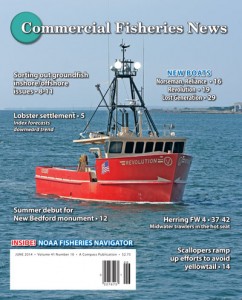Finally, it is spring. The air is noticeably warmer and soon the water will be warmer too, but not warm enough that you would want to spend a lot of time in it waiting for rescue should you go overboard.
The injury epidemiologists might bring out Haddon’s matrix at this point. This tool can be used to analyze a situation and then plan an intervention. Table 1 on this page is a Haddon matrix example from the lobster fishery based on a scenario of entanglement in trap rope that pulls a lobsterman over the rail.
In any fishing casualty scenario there are factors that a fisherman cannot control, factors he or she
cannot predict, and factors he can control or mitigate.
Those who fish in New England’s offshore waters know they will encounter cold water and, north of the Isles of Shoals off Portsmouth, the water temperature meets the Coast Guard’s criterion for cold water year-round (except in the estuaries and bays). Water temperature is a factor one cannot control.
A fisherman also cannot predict whether there will be any Good Samaritan vessels in the vicinity if he needs assistance. Of course, a fisherman usually can’t predict when he is going to get into trouble either. Which rope loop will catch him off guard?
Interventions
Then there are factors a fisherman can control. We have done a lot of teaching and talking with fishermen about ways to control the rope – rope bins, rope lockers, fairleads, and hot tanks – and the importance of having a knife on your person, oilskins, or belt.
Judging from conversations at this year’s Maine Fishermen’s Forum, an increasing number of fishermen seem to be hearing those safety messages. Safety trainers and I in this column have stressed the importance of PFDs, but adherence to this important advice is still poor even though there are very comfortable, light-weight, easy to
work-in PFDs on the market.
We have not drawn as much attention to one other survival-related factor that fishermen can control – that of being able to reboard the boat.
In talking with fishermen, we have learned about a variety of reboarding devices they have placed on their boats, including ladders, swimming platforms, hand holds, and steps. Some fishermen plan to use their scuppers for a boost, though one wonders if they’ve ever tried it.
One clever lobsterman and his sternman figured out how to use the winch and a lobster trap to raise a man overboard to the rail. That and other strategies can work if you have two people on board.
But for fishermen working alone, one possible solution is a simple rope ladder, or Coast Guard “second chance” ladder. From a single six-fathom length of 3/8″ line, one can make a serviceable rope ladder to loop over the stern cleat and lower down before leaving anchor.
Taller fishermen will want more line in order to leave a larger distance between the rungs, perhaps a little more than half the distance between foot and knee.
Also, one should buy more line if the distance from the stern cleat to the transom is more than 1′ and possibly if wider rungs are needed to accommodate wide boots. Regulations that went into effect in January 2009 require fishing vessels with 4′ or more of freeboard to have a “pilot ladder.”
Fishermen have voiced concerns that a rope ladder flapping under the stern might slow them down. However, one can loop the ladder onto a simple hanger on the transom.
Finally, a fisherman who finds himself in a Good Samaritan role can save time, energy, and back strain by having a rope ladder on board to offer a cold, exhausted colleague a leg up.
Ann Backus, MS, is the director of outreach for the Harvard School of Public Health’s Department of Environmental Health in Boston, MA. She may be reached by phone at (617) 432-3327 or by e-mail at <abackus@hsph.harvard.edu>.

Read the rest and much, much more in the June issue of Commercial Fisheries News.
Read online immediately and download for future reference.







 Updating...
Updating...